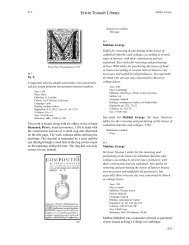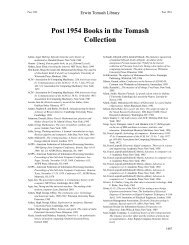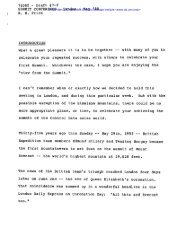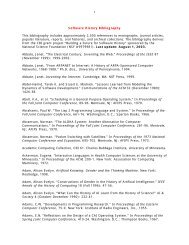B chapter.indd - Charles Babbage Institute - University of Minnesota
B chapter.indd - Charles Babbage Institute - University of Minnesota
B chapter.indd - Charles Babbage Institute - University of Minnesota
Create successful ePaper yourself
Turn your PDF publications into a flip-book with our unique Google optimized e-Paper software.
Erwin Tomash Library<br />
Brown, George Brown, George<br />
B 270<br />
Brown, George (1650–1730)<br />
Arithmetica infinita or the accurate accomptant’s best<br />
companion contriv’d and calculated …<br />
Year: 1717/1718 Julian/Gregorian<br />
Place: [Edinburgh]<br />
Publisher: Brown<br />
Edition: 1st<br />
Language: English<br />
Figures: engraved portrait frontispiece<br />
Binding: contemporary panelled leather<br />
Pagination: pp. [4], 14, 126, 10<br />
Collation: π 2 a 7 A–H 8 I 4<br />
Size: 95x120 mm<br />
B 270<br />
George Brown was a Scottish minister who apparently<br />
graduated from the <strong>University</strong> <strong>of</strong> Aberdeen in 1675<br />
(another account has him graduating from Edinburgh<br />
<strong>University</strong> in 1664, but he would only have been 14 at<br />
that time – not impossible for the time, but unusual).<br />
He apparently served in various parishes in Scotland,<br />
but after the revolution <strong>of</strong> 1688, he lost his license to<br />
practice. He created a device known as a Rotula, a<br />
circular instrument for performing elementary arithmetic<br />
operations, and published works on arithmetic and tables<br />
for the conversion <strong>of</strong> English to Scots currency. For<br />
information on the Rotula, see Duncan Wilson, “The<br />
Rotula, a seventeenth century calculating device,” The<br />
Scottish Educational Journal, April 14, 1933, pp. 432–<br />
433.<br />
Brown’s last publication, this small book <strong>of</strong> tables was<br />
engraved, excepting one typeset page bearing a letter<br />
from the astronomer John Keill recommending the use<br />
<strong>of</strong> the tables. The two tables are each concerned with<br />
interest and do not use a decimal point but rather a small<br />
∟ symbol. A manuscript page, pasted into the front,<br />
explains that the tables are artificial numbers, adopted to<br />
our English money: 1₤ or twenty shillings sterling being<br />
the Integer (see illustration).<br />
Illustrations available:<br />
Title page<br />
Frontispiece <strong>of</strong> Brown<br />
Sample table page<br />
Manuscript page <strong>of</strong> explanation<br />
B 271<br />
Brown, George (1650–1730)<br />
George Brown, B 270<br />
Table, B 270<br />
A compendious, but a compleat system <strong>of</strong> decimal<br />
arithmetick, containing more exact rules for ordering<br />
infinites, than any hitherto extant.<br />
Year: 1701<br />
Place: Edinburgh<br />
Publisher: Brown<br />
Edition: 1st<br />
Language: English<br />
Binding: contemporary leather<br />
Pagination: pp. 68<br />
Collation: A–E 4 F–G 2 H–I 4 K 2<br />
Size: 175x142 mm<br />
This is an elementary arithmetic beginning with a<br />
description <strong>of</strong> the four basic operations. The last half<br />
presents the rule <strong>of</strong> three and a few simple business<br />
problems. The final section on compound interest<br />
illustrates the process with logarithms but does not<br />
include a table.<br />
Illustrations available:<br />
Title page<br />
213







